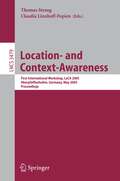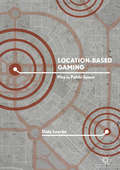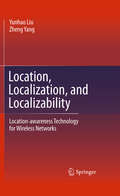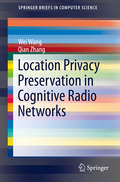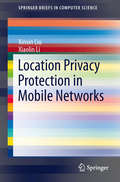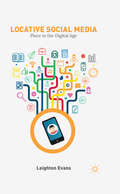- Table View
- List View
Location and Context Awareness: 4th International Symposium, LoCA 2009 Tokyo, Japan, May 7-8, 2009 Proceedings (Lecture Notes in Computer Science #5561)
by Tanzeem Choudhury Aaron Quigley Thomas Strang Koji SuginumaThese proceedings contain the papers presented at the 4th International S- posium on Location and Context Awareness (LoCA) during May 7–8, 2009 in Tokyo,Japan.Locationandcontextawarenessarefundamentstonext-generation mobile and pervasive computing systems. Pervasive computing is a model of computing in which computation is everywhere and computer functions are - tegrated into everything. The ultimate aim is to make information, applications and services available anywhere and at anytime in the human environment in a ?uid manner appropriate to our current context. Once away from the desktop, we ?nd ourselves in a wide variety of contexts and hence situations. For computing to be relevant and useful in these emerging situations we must rely on a range of contextual cues. Context includes phys- logical, environmental, and computational data, whether sensed or inferred. In addition, context includes details of a user’s activities, goals, abilities, pref- ences, a?ordances, and surroundings. With location and context awareness we can expect computers to deliver information, services, and entertainment in a way that maximizes convenience and minimizes intrusion.
Location- and Context-Awareness: Second International Workshop, LoCA 2006, Dublin, Ireland, May 10-11, 2006, Proceedings (Lecture Notes in Computer Science #3987)
by Mike Hazas John Krumm Thomas StrangThis book constitutes the refereed proceedings of the Second International Workshop on Location- and Context-Awareness, LoCA 2006, held in Dublin, Ireland, in May 2006. The 18 revised full papers presented were carefully selected during two rounds of reviewing and improvement from 74 submissions. The papers are organized in topical sections on location sensing, mapping, privacy and access, context sensing, social context, representation and programming.
Location- and Context-Awareness: Third International Symposium, LoCA 2007, Oberpfaffenhofen, Germany, September 20-21, 2007, Proceedings (Lecture Notes in Computer Science #4718)
by Jeffrey Hightower Bernt Schiele Thomas StrangThis book constitutes the refereed proceedings of the Third International Symposium on Location- and Context-Awareness, LoCA 2007, held in Oberpfaffenhofen, Germany, in September 2007. The papers are organized in topical sections on wifi location technology, activity and situational awareness, taxonomies, architectures, and in a broader perspective, the meaning of place, radio issue in location technology, and new approaches to location estimation.
Location- and Context-Awareness: First International Workshop, LoCA 2005, Oberpfaffenhofen, Germany, May 12-13, 2005, Proceedings (Lecture Notes in Computer Science #3479)
by Thomas Strang Claudia Linnhoff-PopienContext-awareness is one of the drivers of the ubiquitous computing paradigm. Well-designed context modeling and context retrieval approaches are key p- requisites in any context-aware system. Location is one of the primary aspects of all major context models — together with time, identity and activity. From the technical side, sensing, fusing and distributing location and other context information is as important as providing context-awareness to applications and services in pervasive systems. Thematerialsummarizedinthisvolumewasselectedforthe1stInternational Workshop on Location- and Context-Awareness (LoCA 2005) held in coope- tion with the 3rd International Conference on Pervasive Computing 2005. The workshop was organized by the Institute of Communications and Navigation of the German Aerospace Center (DLR) in Oberpfa?enhofen, and the Mobile and Distributed Systems Group of the University of Munich. During the workshop, novel positioning algorithms and location sensing te- niques were discussed, comprising not only enhancements of singular systems, like positioning in GSM or WLAN, but also hybrid technologies, such as the integration of global satellite systems with inertial positioning. Furthermore, - provements in sensor technology, as well as the integration and fusion of sensors, were addressed both on a theoretical and on an implementation level. Personal and con?dential data, such as location data of users, have p- found implications for personal information privacy. Thus privacy protection, privacy-oriented location-aware systems, and how privacy a?ects the feasibility and usefulness of systems were also addressed in the workshop.
Location Awareness in the Age of Google Maps
by Rebecca NooneLocation Awareness in the Age of Google Maps explores the mundane act of navigating cities in the age of digital mapping infrastructures.Noone follows the frictions routing through Google Maps’ categorising and classifying of spatial information. Complicating the assumption that digital maps distort a sense of direction, Noone argues that Google Maps’ location awareness does more than just organise and orient a representation of space—it also organises and orients imaginaries of publicness, selfsufficiency, legibility, and error. At the same time, Location Awareness in the Age of Google Maps helps to animate the ordinary ways people are challenging and refusing Google Maps’ vision of the world. Drawing on an arts-based field study spanning the streets of London, New York, London, Toronto, and Amsterdam, Noone’s encounters of "asking for directions" open up lines of inquiry and spatial scores that cut through Google‘s universal mapping project.Location Awareness in the Age of Google Maps will be essential reading for information studies and media studies scholars and students with an interest in embodied information practices, critical information studies, and critical data studies. The book will also appeal to an urban studies audience engaged in work on the digital city and the datafication of urban environments.
Location Awareness in the Age of Google Maps
by Rebecca NooneLocation Awareness in the Age of Google Maps explores the mundane act of navigating cities in the age of digital mapping infrastructures.Noone follows the frictions routing through Google Maps’ categorising and classifying of spatial information. Complicating the assumption that digital maps distort a sense of direction, Noone argues that Google Maps’ location awareness does more than just organise and orient a representation of space—it also organises and orients imaginaries of publicness, selfsufficiency, legibility, and error. At the same time, Location Awareness in the Age of Google Maps helps to animate the ordinary ways people are challenging and refusing Google Maps’ vision of the world. Drawing on an arts-based field study spanning the streets of London, New York, London, Toronto, and Amsterdam, Noone’s encounters of "asking for directions" open up lines of inquiry and spatial scores that cut through Google‘s universal mapping project.Location Awareness in the Age of Google Maps will be essential reading for information studies and media studies scholars and students with an interest in embodied information practices, critical information studies, and critical data studies. The book will also appeal to an urban studies audience engaged in work on the digital city and the datafication of urban environments.
Location-Based Gaming: Play in Public Space
by Dale LeorkeLocation-based games emerged in the early 2000s following the commercialisation of GPS and artistic experimentation with ‘locative media’ technologies. Location-based games are played in everyday public spaces using GPS and networked, mobile technologies to track their players’ location. This book traces the evolution of location-based gaming, from its emergence as a marginal practice to its recent popularisation through smartphone apps like Pokémon Go and its incorporation into ‘smart city’ strategies. Drawing on this history and an analysis of the scholarly and mainstream literature on location-based games, Leorke unpacks the key claims made about them. These claims position location-based games as alternately enriching or diminishing their players’ engagement with the people and places they encounter through the game. Through rich case studies and interviews with location-based game designers and players, Leorke tests out and challenges these celebratory and pessimistic discourses. He argues for a more grounded approach to researching location-based games and their impact on public space that reflects the ideologies, lived experiences, and institutional imperatives that circulate around their design and performance. By situating location-based games within broader debates about the role of play and digitisation in public life, Location-Based Gaming offers an original and timely account of location-based gaming and its growing prominence.
Location-Based Gaming: Play in Public Space
by Dale LeorkeLocation-based games emerged in the early 2000s following the commercialisation of GPS and artistic experimentation with ‘locative media’ technologies. Location-based games are played in everyday public spaces using GPS and networked, mobile technologies to track their players’ location. This book traces the evolution of location-based gaming, from its emergence as a marginal practice to its recent popularisation through smartphone apps like Pokémon Go and its incorporation into ‘smart city’ strategies. Drawing on this history and an analysis of the scholarly and mainstream literature on location-based games, Leorke unpacks the key claims made about them. These claims position location-based games as alternately enriching or diminishing their players’ engagement with the people and places they encounter through the game. Through rich case studies and interviews with location-based game designers and players, Leorke tests out and challenges these celebratory and pessimistic discourses. He argues for a more grounded approach to researching location-based games and their impact on public space that reflects the ideologies, lived experiences, and institutional imperatives that circulate around their design and performance. By situating location-based games within broader debates about the role of play and digitisation in public life, Location-Based Gaming offers an original and timely account of location-based gaming and its growing prominence.
Location-Based Mobile Games: Design Perspectives (SpringerBriefs in Applied Sciences and Technology)
by Davide Spallazzo Ilaria MarianiThis book approaches Location Based Mobile Games from a design perspective, investigating the peculiar traits that make them compelling contemporary practices and challenging fields of investigation. Relying on an interdisciplinary theoretical background and empirical studies, it delves into LBMGs’ intertwining theoretical assumptions and describes their translation into practice. The authors examine these games from different perspectives, exploring how they can impact the way we look at our surroundings, their influence on our social dimension, their ability to translate a wide range of information into a game experience, and the negotiations they activate by intertwining two realities. Each issue is addressed from a twofold perspective: that of the designers who craft the games, and that of the users who interpret the designers’ choices and take part in the game experience. In so doing, the book covers the relationship between processes of designing and playing, investigating games that communicate through meaningful interactions, share perspectives as forms of narratives, and integrate physicality and surroundings in the play activity. The reasoning advanced throughout the chapters will benefit researchers, designers and entrepreneurs in the field, as it provides a novel perspective on LBMGs, seeks to increase designers’ awareness of often-neglected issues, and suggests interpretations and practices that can impact how commercial games are designed.
Location-Based Services (The Morgan Kaufmann Series in Data Management Systems)
by Jochen Schiller Agnès VoisardLocation-based services (LBS) are a new concept integrating a user's geographic location with the general notion of services, such as dialing an emergency number from a cell phone or using a navigation system in a car. Incorporating both mobile communication and spatial data, these applications represent a novel challenge both conceptually and technically. The purpose of this book is to describe, in an accessible fashion, the various concepts underlying mobile location-based services. These range from general application-related ideas to technical aspects. Each chapter starts with a high level of abstraction and drills down to the technical details. Contributors examine each application from all necessary perspectives, namely, requirements, services, data, and scalability. An illustrative example begins early in the book and runs throughout, serving as a reference.· This book defines the LBS field and identifies its capabilities, challenges, and technologies.· The contributors are recognized experts from academia and industry.· Coverage includes navigation systems, middleware, interoperability, standards, and mobile communications.· A sample application, the "find-friend" application, is used throughout the book to integrate the concepts discussed in each chapter.
Location Based Services and TeleCartography (Lecture Notes in Geoinformation and Cartography)
by Georg Gartner William Cartwright Michael P. PetersonThis book provides for the first time a general overview of research activities related to location and map-based services. These activities have emerged over the last years, especially around issues of positioning, spatial modelling, cartographic communication as well as in the fields of ubiquitious cartography, geo-pervasive services, user-centered modelling and geo-wiki activities. The innovative and contemporary character of these topics has lead to a great variety of interdisciplinary contributions, from academia to business, from computer science to geodesy. Topics cover an enormous range with heterogenous relationships to the main book issues. Whilst contemporary cartography aims at looking at new and efficient ways for communicating spatial information the development and availability of technologies like mobile networking, mobile devices or short-range sensors lead to interesting new possibilities for achieving this aim. By trying to make use of available technologies, cartography and a variety of related disciplines look specifically at user-centered and conte- aware system development, as well as new forms of supporting wayfinding and navigation systems. Contributions are provided in five main sections and they cover all of these aspects and give a picture of the new and expanding field of Location Based Services and TeleCartography. Georg Gartner, Vienna, Austria William Cartwright, Melbourne, Australia Michael Peterson, Omaha, USA Table of Contents Georg Gartner LBS and TeleCartography: About the book. . . . . . . . . . . . . . . . . . . . . . . . . . . . . . . . . . . . . . . . . . . 1 1 A series of Symposiums on LBS and TeleCartography. . . . . . . . . . . . . . . . . . . . . . 1 2 Progression of Research . . . . . . . . . . . . . . . . . . . . . . . . . . . . . . . . . . . . . . . . . . . . . . . . . . . . . . . . . . . . . . . . . . . . . . 3 2. 1 Terms. . . . . . . . . . . . . . . . . . . . . . . . . . . . . . . . . . . . . . . . . . . . . . . . . . . . . . . . . . . . . . . . . . . . . . . . . . . . . . . . . . . . . . . . . . . . 3 2. 2 Elements. . . . . . . . . . . . . . . . . . . . . . . . . . . . . . . . . . . . . . . . . . . . . . . . . . . . . . . . . . . . . . . . . . . . . . . . . . . . . . . . . . . . . . . 4 3 Structure of the book . . . . . . . . . . . . . . . . . . . . . . . . . . . . . . . . . . . . . . . . . . . . . . . . . . . . . . . . . . . . . . . . . . . . . . . . . . .
Location-Based Services Handbook: Applications, Technologies, and Security
by Syed A. Ahson Mohammad IlyasLocation-Based Services Handbook: Applications, Technologies, and Security is a comprehensive reference containing all aspects of essential technical information on location-based services (LBS) technology. With broad coverage ranging from basic concepts to research-grade material, it presents a much-needed overview of technologies for positioning and localizing, including range- and proximity-based localization methods, and environment-based location estimation methods. Featuring valuable contributions from field experts around the world, this book addresses existing and future directions of LBS technology, exploring how it can be used to optimize resource allocation and improve cooperation in wireless networks. It is a self-contained, comprehensive resource that presents: A detailed description of the wireless location positioning technology used in LBS Coverage of the privacy and protection procedure for cellular networks—and its shortcomings An assessment of threats presented when location information is divulged to unauthorized parties Important IP Multimedia Subsystem and IMS-based presence service proposals The demand for navigation services is predicted to rise by a combined annual growth rate of more than 104 percent between 2008 and 2012, and many of these applications require efficient and highly scalable system architecture and system services to support dissemination of location-dependent resources and information to a large and growing number of mobile users. This book offers tools to aid in determining the optimal distance measurement system for a given situation by assessing factors including complexity, accuracy, and environment. It provides an extensive survey of existing literature and proposes a novel, widely applicable, and highly scalable architecture solution. Organized into three major sections—applications, technologies, and security—this material fully covers various location-based applications and the impact they will have on the future.
Location-Based Services Handbook: Applications, Technologies, and Security
by Syed A. Ahson and Mohammad IlyasLocation-Based Services Handbook: Applications, Technologies, and Security is a comprehensive reference containing all aspects of essential technical information on location-based services (LBS) technology. With broad coverage ranging from basic concepts to research-grade material, it presents a much-needed overview of technologies for positioning and localizing, including range- and proximity-based localization methods, and environment-based location estimation methods. Featuring valuable contributions from field experts around the world, this book addresses existing and future directions of LBS technology, exploring how it can be used to optimize resource allocation and improve cooperation in wireless networks. It is a self-contained, comprehensive resource that presents: A detailed description of the wireless location positioning technology used in LBS Coverage of the privacy and protection procedure for cellular networks—and its shortcomings An assessment of threats presented when location information is divulged to unauthorized parties Important IP Multimedia Subsystem and IMS-based presence service proposals The demand for navigation services is predicted to rise by a combined annual growth rate of more than 104 percent between 2008 and 2012, and many of these applications require efficient and highly scalable system architecture and system services to support dissemination of location-dependent resources and information to a large and growing number of mobile users. This book offers tools to aid in determining the optimal distance measurement system for a given situation by assessing factors including complexity, accuracy, and environment. It provides an extensive survey of existing literature and proposes a novel, widely applicable, and highly scalable architecture solution. Organized into three major sections—applications, technologies, and security—this material fully covers various location-based applications and the impact they will have on the future.
Location, Localization, and Localizability: Location-awareness Technology for Wireless Networks
by Yunhao Liu Zheng YangThis book reflects up-to-date research, fundamental theories, and key techniques of of wireless localization technology and error-controlling techniques. It also presents and discusses the issue of localizability, as well as privacy issues associated with LBS. This book encompasses the significant and quickly growing area of wireless localization technology. It presents comprehensive and up-to-date research in both fundamental theories and key techniques of network localization. In addition to localization approaches, it also is the first book to address the issue of localizability. The privacy issue of LBS technology is also discussed.
Location, Localization, and Localizability: Location-awareness Technology for Wireless Networks
by Yunhao Liu Zheng YangTime flies since the debut of this book. In the past ten years, localization technology has evolved from small saplings into towering trees. Robots and drones with autonomous positioning and navigation capabilities, once considered unreachable fantasies, have gradually become a reality. However, while we are being amazed at the groundbreaking changes brought about by technology, as researchers, we still need to remain acutely attentive to the current limitations of localization. Some significant challenges still impede the widespread deployment. For example, traditional Wi-Fi fingerprint-based wireless localization, due to various challenges in fingerprint database collection and maintenance, has remained stay in the laboratory, and even when using smartphones for localization in malls, we still cannot achieve the outdoor GPS-like experience. The list goes on and on. Against this backdrop, the reissue of this book aims to more comprehensively reflect the latest developments in localization technology. We have added introductions to emerging technologies such as passive high-precision localization based on wireless signal CSl and autonomous localization for smart devices. Additionally, we have integrated and further streamlined technical chapters that now appear outdated adapting to the pace of the times. This book aims to provide a comprehensive and in-depth view of location-awareness technology in today’s popular wireless networks. However, the obvious diversity of networks, from short-range Bluetooth to long-range telecommunication networks, makes it very challenging to organize materials. Although general principles exist, the implementation differs from network to network and application to application. The book can serve as a guidebook for the technicians and practitioners in the industry of location systems. They can expect to obtain a comprehensive understanding of the field, in order to compare and select localization solutions fulfilling various application requirements. Abundant references in the book open up a broader domain for advanced study. In addition, the book is tailored toward a textbook for college researchers and graduate students.
Location Privacy in Mobile Applications (SpringerBriefs on Cyber Security Systems and Networks)
by Bo Liu Wanlei Zhou Tianqing Zhu Yong Xiang Kun WangThis book provides a comprehensive study of the state of the art in location privacy for mobile applications. It presents an integrated five-part framework for location privacy research, which includes the analysis of location privacy definitions, attacks and adversaries, location privacy protection methods, location privacy metrics, and location-based mobile applications. In addition, it analyses the relationships between the various elements of location privacy, and elaborates on real-world attacks in a specific application. Furthermore, the book features case studies of three applications and shares valuable insights into future research directions. Shedding new light on key research issues in location privacy and promoting the advance and development of future location-based mobile applications, it will be of interest to a broad readership, from students to researchers and engineers in the field.
Location Privacy in Wireless Sensor Networks (Series in Security, Privacy and Trust)
by Ruben Rios Javier Lopez Jorge CuellarToday all kinds of ubiquitous systems, led by wireless sensor networks, can be seen as an unprecedented privacy risk given their ability to collect information on quantities and situations so far unsuspected. There is therefore an urgent need to develop mechanisms to ensure privacy in sensor networks. Location Privacy in Wireless Sensor Networks focuses on location privacy, by which an attacker might determine the source and destination of communications with simple techniques. This poses a serious threat as the attacker might use this information to reach the assets or individuals being monitored or even to destroy or compromise the whole network. This book will aid in the protection against this serious privacy threat.
Location Privacy in Wireless Sensor Networks (Series in Security, Privacy and Trust)
by Ruben Rios Javier Lopez Jorge CuellarToday all kinds of ubiquitous systems, led by wireless sensor networks, can be seen as an unprecedented privacy risk given their ability to collect information on quantities and situations so far unsuspected. There is therefore an urgent need to develop mechanisms to ensure privacy in sensor networks. Location Privacy in Wireless Sensor Networks focuses on location privacy, by which an attacker might determine the source and destination of communications with simple techniques. This poses a serious threat as the attacker might use this information to reach the assets or individuals being monitored or even to destroy or compromise the whole network. This book will aid in the protection against this serious privacy threat.
Location Privacy Preservation in Cognitive Radio Networks (SpringerBriefs in Computer Science)
by Wei Wang Qian ZhangThis brief focuses on the current research on location privacy preservation in cognitive radio networks (CRNs). Along with a review of the existing works, this book includes fundamental privacy models, possible frameworks, useful performance, and future research directions. It explores privacy preservation techniques, collaborative spectrum sensing, database-driven CRNS, and modeling potential privacy threats. Conflicts between database owners and unlicensed users can compromise location privacy, and CRNs are a means to mitigate the spectrum scarcity issue due to the increasing demand for wireless channel resources. By examining the current and potential privacy threats, the authors equip readers to understand this developing issue. The brief is designed for researchers and professionals working with computer communication networks and cognitive radio networks. Graduate students interested in networks and communication engineering will also find the brief helpful.
Location Privacy Protection in Mobile Networks (SpringerBriefs in Computer Science)
by Xinxin Liu Xiaolin LiThis SpringerBrief analyzes the potential privacy threats in wireless and mobile network environments, and reviews some existing works. It proposes multiple privacy preserving techniques against several types of privacy threats that are targeting users in a mobile network environment. Depending on the network architecture, different approaches can be adopted. The first proposed approach considers a three-party system architecture where there is a trusted central authority that can be used to protect users’ privacy. The second approach considers a totally distributed environment where users perform privacy protection by themselves. Finally, more general system architecture is discussed including how a semi-trusted server may exist, but users need to collaborate to achieve maximized privacy protection. This brief is designed for researchers and professionals working with privacy preservation, mobile networks, and threat models. The variety of approaches presented makes it useful for students as well.
Location Systems: An Introduction to the Technology Behind Location Awareness (Synthesis Lectures on Mobile & Pervasive Computing)
by Anthony LaMarca Eyal de LaraAdvances in electronic location technology and the coming of age of mobile computing have opened the door for location-aware applications to permeate all aspects of everyday life. Location is at the core of a large number of high-value applications ranging from the life-and-death context of emergency response to serendipitous social meet-ups. For example, the market for GPS products and services alone is expected to grow to US$200 billion by 2015. Unfortunately, there is no single location technology that is good for every situation and exhibits high accuracy, low cost, and universal coverage. In fact, high accuracy and good coverage seldom coexist, and when they do, it comes at an extreme cost. Instead, the modern localization landscape is a kaleidoscope of location systems based on a multitude of different technologies including satellite, mobile telephony, 802.11, ultrasound, and infrared among others. This lecture introduces researchers and developers to the most popular technologies and systems for location estimation and the challenges and opportunities that accompany their use. For each technology, we discuss the history of its development, the various systems that are based on it, and their trade-offs and their effects on cost and performance. We also describe technology-independent algorithms that are commonly used to smooth streams of location estimates and improve the accuracy of object tracking. Finally, we provide an overview of the wide variety of application domains where location plays a key role, and discuss opportunities and new technologies on the horizon. Table of Contents: Introduction / The Global Positioning System / Infrared and Ultrasonic Systems / Location Esimation with 802.11 / Cellular-Based Systems / Other Approaches / Improving Localization Accuracy / Location-Based Applications and Services / Challenges and Opportunities / References
Locative Media (Routledge Studies in New Media and Cyberculture)
by Rowan Wilken Gerard GogginNot only is locative media one of the fastest growing areas in digital technology, but questions of location and location-awareness are increasingly central to our contemporary engagements with online and mobile media, and indeed media and culture generally. This volume is a comprehensive account of the various location-based technologies, services, applications, and cultures, as media, with an aim to identify, inventory, explore, and critique their cultural, economic, political, social, and policy dimensions internationally. In particular, the collection is organized around the perception that the growth of locative media gives rise to a number of crucial questions concerning the areas of culture, economy, and policy.
Locative Media (Routledge Studies in New Media and Cyberculture)
by Rowan Wilken Gerard GogginNot only is locative media one of the fastest growing areas in digital technology, but questions of location and location-awareness are increasingly central to our contemporary engagements with online and mobile media, and indeed media and culture generally. This volume is a comprehensive account of the various location-based technologies, services, applications, and cultures, as media, with an aim to identify, inventory, explore, and critique their cultural, economic, political, social, and policy dimensions internationally. In particular, the collection is organized around the perception that the growth of locative media gives rise to a number of crucial questions concerning the areas of culture, economy, and policy.
Locative Social Media: Place in the Digital Age
by L. EvansThis book offers a critical analysis of the effect of usage of locative social media on the perceptions and phenomenal experience of lived in spaces and places. Drawing on users accounts of location-based social networking, a digital post-phenomenology of place is developed to explain how place is mediated in the digital age.
Lockdown Parenting Fails: (Because it's not all f*cking rainbows!)
by Nathan JoyceDid your home haircut make your child look like Friar Tuck?Did you forget to put bananas in your banana bread?Did your primary-schooler have to correct your times tables?Then you were probably one of many people trying your f*cking hardest to parent during lockdown, and so now deserve a medal (or a case of gin).Featuring entries from fellow survivors on the horrors of homeschooling, the nightmares of kitchen experiments, the fallibility of trying to keep your colleagues' respect, the inevitability of putting on all the weight and the joys of considering what you did to make the world punish you so......Lockdown Parenting Fails is a hilarious (and trauma-inducing) collection of the best memories from the worst time in everyone's lives.



